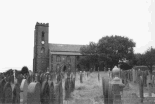Cawl Terrace, Rawtenstall
No Picture Available
In 1839 Sion Baptist Church at Higher Cloughfold erected the second church to accommodate the growing congregation which was still using the house that James Townsend had licensed for worship in 1701. This new building itself had to be enlarged in 1854 and with the numbers still growing it was decided in 1864 to open a branch Sunday School at Cawl Terrace. The new Sunday School was erected on land owned by Mr. Richard Ashworth of Lea Bank on the site that is now occupied by the church of St John the Devine, Cloughfold.
The church owed its origin to the Rev, W C H. Anson, who was the pastor of Sion Church from 1859 to 1865. In early 1865 the Sunday School at Cawl Terrace started holding evening services and this caused a division between the members of Sion Church and Rev. Anson, and after a number of disputes the church minutes for 28th October record "That the Church and its minister sever connection on the second Sunday in November". The Rev Anson arranged for a supply minister to attend at Sion and opened the Cawl Terrace School for church services as an independent Baptist Church.
The first page of minute book for the newly independent church reads:
In the month of October 1865, fourteen persons heretofore members of the Baptist Church, Coughfold, being greatly dissatisfied with the state of affairs in the above church and feeling deeply the destitute condition of Cawl Terrace, determined with God's assistance to form themselves into a Church and to attempt the evangelisation of the neighbourhood. Accordingly on the 16th day of the month they assembled in the classroom of the Irwell School, kindly lent by Rd. Ashworth Esq. of Lea Bank and Irwell Mill and passed the following resolutions:
1) That there be a church formed at the Irwell School Room, Cawl Terrace.
2) That George Henry Ormerod be secretary of the Church.
3) That we invite The Rev. W. C. H. Anson to become our pastor on the condition that he serve the first year for what we can collect along with a donation from Rd. Ashworth Esq. of an equal amount, the same being generously promised.
4) That there be a meeting on October 25th for the purpose of engaging the Irwell School Room for teaching and public worship, and that Mary Lord see Mr Ashworth and invite him to attend the said meeting.
The church opened for public worship on Sunday November 12th 1865 and in the early days the church did quite well. But soon it's fortunes began to change though it is difficult to establish what was going wrong as the Secretaries of the church left blank pages in the minutes book which may have disclosed any disputes. For the next few years until January 1870 when Mr Anson was in Italy and the church was having difficulty obtaining supply pastors from Bury College. Then on February 5th the minutes record "That a deputation wait upon Mrs. Anson to see about certain language she is said to have used greatly to the discredit of the Church". Later that same month there is reference to a vote to be taken by ballot "as to whether Mr. Anson stay with us as our minister or not"
The vote went in favour of Mr. Anson and on the March 5th it was agreed "That we engage Mr. Anson at the sum of £60 per annum", but this was not to last on in the minutes of June 26th 1870 appears "That we accept the resignation of the Rev. W. C. H. Anson and that , as requested, his duties to this Church end on the second Sunday in July"
For the next eighteen months the Church continued without a Pastor, paying ten shillings per Sunday for Supply Pastors, but things remained unsettled and on December 6th 1871 the Church passed the following resolution:-
1) That we do not carry on the place any longer as a separate church.
2) That if the Cloughfold Church sends us an invitation to unite with them we accept.
The invitation to unite was cordially accepted by Rev. A. J. Parry and the Cawl Terrace Church ceased to exist as separate Church with thirty of its members transferred to the Cloughfold Church. The building was retained as a branch Sunday School until August 1877.
In 1882 the Church and land were sold for £100 to the Rev. Ezra Holliday vicar of St Mary's Church Rawtenstall and it was run as a School/Church until 1889 when the church of St John the Divine was built on the land.




